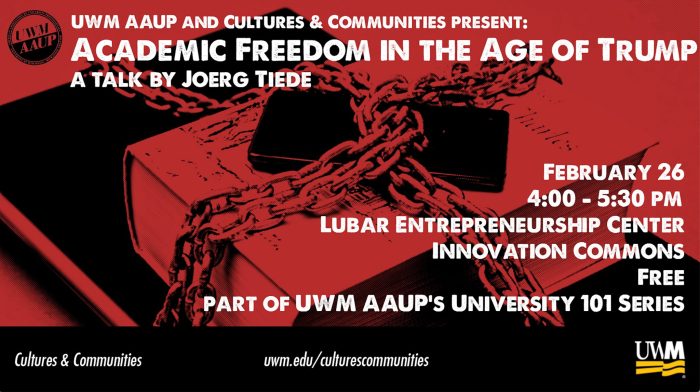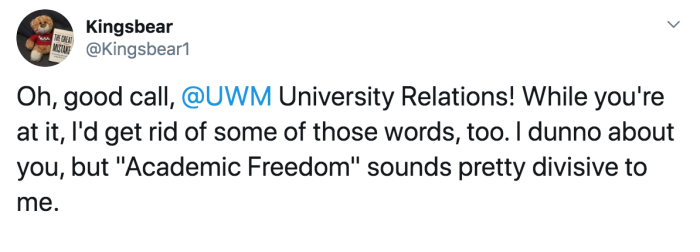BY JOEL BERKOWITZ
We thought the process would be straightforward. As it turns out, things got twisted. More than once.
It all started with a simple invitation. As president of my campus’s chapter of the AAUP, I invited Joerg Tiede, senior program officer and researcher for the national organization, to come to campus to give a presentation of his choosing on academic freedom, a subject on which he is a leading authority. Joerg proposed a talk with the title “Academic Freedom in the Age of Trump,” and given the self-evident relevance of that topic, I readily agreed to host the lecture, which many of my colleagues expressed an interest in attending.
A couple of weeks ago, my fellow UWM AAUP officer Rachel Buff and I turned to a graphic designer employed by the university to create a flyer to help publicize the event. We planned to disseminate the flyer via the chapter’s social media accounts as well as personal ones, and also display it on a number of electronic screens overseen by UWM’s University Relations office. We approved the design below, and expected to start seeing it displayed on the university’s screens before long. That’s not what happened next, however.

On February 13th, Rachel was notified that “the digital ad … has been rejected by University Relations. The reasoning was that it had a partisan tone due to the combination of the word ‘Trump,’ the red color, and the imagery of books in chains. This is a University Relations … decision.” We were told in the same message that we could (1) “re-submit something that removes the items being questioned,” (2) appeal the rejection (at a meeting scheduled to take place the day before the event), or (3) email the two senior staff members in in the University Relations office to express our concerns.
While pondering our next move, Rachel and I started posting about the rejection on social media, and our tweets were quickly amplified by others. Dave Vanness, no longer in Wisconsin but a former president of UW-Madison’s AAUP chapter, expressed his dismay and tagged the national AAUP’s account as well as that of FIRE, the Foundation for Individual Rights in Education. The AAUP later weighed in with a brief thread of its own. Various commentators, such as University of Minnesota historian Will Jones wrote, noted the irony of publicity materials to promote a presentation on academic freedom being suppressed: “Sad to see my former employer, @UWM, censoring its own faculty for, believe it or not, defending academic freedom! This is why we need the @AAUP @uwmaaup”. Even Wavy, a stuffed bear employed as Brand Ambassador for Kingsborough Community College in New York City, offered some sardonic commentary:

As the buzz on social media got louder, the situation was brought (not by us; we had yet to decide whether or how to appeal the initial rejection) to the attention of Tom Luljak, the Vice Chancellor at the helm of the University Relations office, which informed us the next day that it had reversed its decision and decided to let the ad run on university monitors. In person and on Facebook and Twitter, we celebrated a small victory for academic freedom, and set aside, at least for the moment, any guerilla marketing tactics I can neither confirm nor deny we may have been considering. And that was that.
Except it wasn’t. As this minor tempest in a teapot was apparently dying down, Rachel and I both received emails from Inside Higher Ed reporter Colleen Flaherty, who had gotten wind of the situation and wanted to hear about it directly from us. Each of us quickly replied. In my message, I walked the reporter through my understanding of the timeline, and Rachel and I wondered whether Inside Higher Ed would run anything at all about it, since whatever smoke had been blowing seemed to be amounting to something less than a fire.
On February 18, the website did indeed post a short article about the incident, with the title “(Brief) Censorship Concerns at UW Milwaukee.” The title was fair enough; the article, in my view, was half-baked at best. I said as much in an email I sent to Colleen Flaherty shortly after reading her account, and since that message (edited very slightly here for clarity) sums up most of what I have to say about the matter–from which I would love to move on as soon as possible–I’ll let it serve as the conclusion of this blog post:
Tom Luljak’s comment that the ad was rejected simply isn’t true. As I took pains to explain [in my initial response to the reporter], while University Relations didn’t say we couldn’t use it, they did reject our request to display it on electronic displays that office controls. So for Tom to say that “University Relations never told faculty members that their poster couldn’t be used, but that the institution recently adopted a new approval policy for fliers” is something of a non sequitur. Whether the process is new or not is beside the point. The point is that our submission was initially rejected.
You also say that Tom’s office “quickly approved the ad … after a faculty member tweeted about the incident.” That statement is incomplete at best, if not an outright misrepresentation. If I knew nothing of this incident and read that, I’d conclude from that description that a faculty member … sent a tweet about it, and a short time later (minutes? maybe an hour or two at most?) the university reversed course. What in fact happened was that both of us sent multiple tweets about it, which were amplified by our chapter’s Twitter account and then picked up by colleagues at UWM and other places. The national office of the AAUP weighed in with a short but sharp thread. FIRE and Pen America were pulled into the exchanges too at some point. And all of this unfolded over the course of some 24 hours or so. It wasn’t clear to us until midday on Friday that University Relations had reversed its decision.
For Tom to say that the rejection (which he falsely claims was not a rejection) is “the beginning of a conversation” is—well, I hardly know what to say. Since just about any decision made by a university employee or committee—failing a student, rejecting someone’s application for tenure and promotion, firing someone, et al—is subject to appeal, then I suppose one could claim that any of these things are “the beginning of a conversation.” I can see why Tom might think it’s part of his job to spin events in that manner. I can’t understand why you would simply accept that explanation at face value.
Guest blogger Joel Berkowitz is the Director of the Sam and Helen Stahl Center for Jewish Studies and Professor of Foreign Languages and Literature at the University of Wisconsin-Milwaukee. This article is reprinted with permission from his blog, Campusland.



As one who has found myself many times over in similar challenges with the UW Milwaukee administration over my 30 plus years at UW Milwaukee, I find the university administration’s actions to be an old and tired saw in their playbook. My most serious confrontation was the publication of a newsletter called the UWM News. I was charged with violating trademark, even though at the time the publication was a simple rag, done on a 8-1/2 x 11 piece of white paper and printed on a dot matrix printer. Needless to say, I called their bluff, and the administration backed off.
They based your violation on the combination of the color red, the name of the 45th president of the U.S., and a book in chains. Clearly not actionable. I charge them with bullying and violating the Code of Conduct.
The color red is my color, the 45th president is a public figure, and a chained book, well, it’s a chained book.
These attempts to silence us would be laughable, except they do more than silence us, they amplify their disrespect for thought, creativity and curiosity, and the depth they will take to hide their agenda.
Pingback: Reading: Controversial AAUP Poster at UW-Milwaukee – Morgan's Log
This is the same administration that defended the right of Milo Yiannopoulos to ridicule a student on campus. https://www.lgbtqnation.com/2016/12/milo-yiannopoulos-harasses-transgender-student-stage-milwaukee/